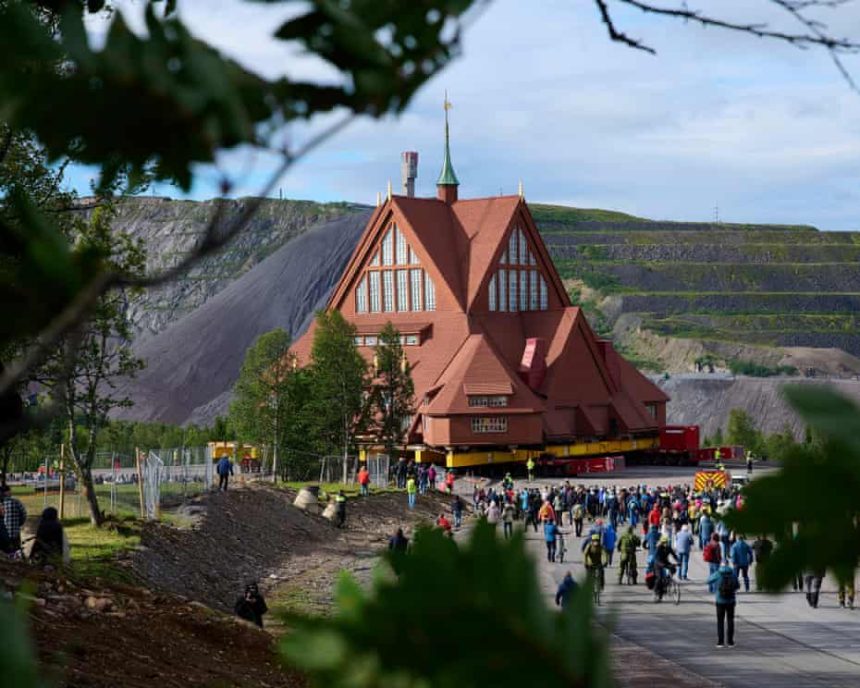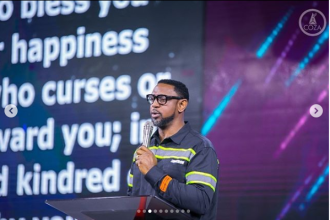After eight years of preparation, a price tag exceeding 500 million kronor (£39m), and an early-morning blessing, a historic church in northern Sweden embarked on a slow-motion 5km journey on Tuesday to make room for the expansion of Europe’s largest underground mine.
The 672-tonne Kiruna Kyrka, a Swedish Lutheran church that first opened its doors in 1912, will be gradually rolled to its new site over two days, moving at a cautious pace of just half a kilometre per hour.
The ambitious relocation is part of a multi-decade plan to move the Arctic town of Kiruna, as the state-owned LKAB iron ore mine undermines the ground, posing a threat to the city itself.
More than 10,000 people, including Swedish King Carl XVI Gustaf, are expected to line the streets, widened specifically to accommodate the church’s passage—to witness the historic move of the red wooden structure.
The operation had already been successfully trialed over a 30-metre stretch during the previous weekend.
In what the broadcaster SVT calls “Den stora kyrkflytten” (the big church move), dozens of cameras have been set up along the route so people across Sweden and around the world can watch this version of “slow TV.”
Designed by Gustaf Wickman, Kiruna Kyrka is one of Sweden’s most beloved historic buildings, notable for its architecture reminiscent of a lávvu, a traditional Sámi hut.
On Wednesday, a church service and coffee event will attempt to break a world record for church coffee. Entertainment will include a concert featuring singer Carola.
While the church is slated to reopen at its new location by the end of next year, the town’s full relocation is expected to continue until 2035.
The church is among 23 cultural buildings being moved in what LKAB has described as “a unique event in world history.” Residents impacted by the mine’s expansion were offered financial compensation or the option to rebuild homes and buildings.
However, the project has faced criticism from the Sámi community, who warn that land fragmentation will disrupt reindeer herding and threaten their Indigenous culture.
Karin K Niia, a reindeer owner and board member of Gabna Sameby, a Sámi village with year-round lands in Kiruna municipality, said the moving of the church was a “big show” meant to distract from the destruction of the town and Indigenous culture.
The church was just “one small part of Kiruna” chosen to be preserved, she said, accusing the company of “land-grabbing” grazing territory vital to Sámi life.
“It feels rather difficult to see the move of the church when I’m well aware of the consequences that mining activities have on everything around it: biodiversity, the air, pollution of water, reindeer and wildlife in general,” she said.
“They have planned it all in order to get people’s attention, media attention on this state-owned company and their action to preserve the church as a symbol for the cultural heritage of Kiruna.”
Stefan Hämäläinen, senior vice president of urban development at LKAB, defended the move: “The move of Kiruna church is necessary for it to continue to exist at all. LKAB has moved a vast amount of buildings in the ongoing urban transformation that began planning over 20 years ago. We are obliged to compensate for what is affected by the mine. In the same way, we seek constructive solutions when mining operations affect reindeer herding, as it is an important part of Sami society and culture.”
Although the company has historically avoided detailing the cost, CEO Jan Moström confirmed Tuesday that it exceeded 500 million kronor, insisting the expense is justified.
“If the mine is to remain, we have to move Kiruna city centre. Kiruna city centre without the church, I can’t see it – so there are no alternatives,” he said during SVT’s live broadcast.
The church’s altarpiece, a pastel landscape by the late Prince Eugen of Sweden, along with its 2,000-pipe organ, have been carefully wrapped for transport. The ground beneath the former location was excavated to allow beams to be placed under the structure.
“The church is sitting on a beam system, then two rows of trailers were brought in,” explained LKAB project manager Stefan Holmblad Johansson. These trailers were slid underneath the beams to facilitate the move.
The bell tower, a separate structure, is scheduled to be relocated next week.






